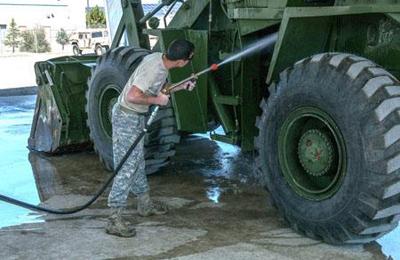EPA Science Matters Newsletter: Gaining from Net Zero (Published November 2013)

EPA scientists join forces with the U.S. Army sustainability initiative to advance decontamination technologies.
EPA scientist Jeff Szabo, Ph.D. and his colleagues are using vehicle cleaning operations on the Kansas Fort Riley military base as an opportunity to advance research into decontamination techniques and technologies. Their work has grown out of a unique partnership between the Agency’s Office of Research and Development and the U.S. Army to support the Army’s Net Zero program, a sustainability initiative focused on reducing energy and water consumption, and waste on military bases (see sidebar: Net Zero).
At Fort Riley, soldiers use high pressure water cannons to clean military vehicles returning from training exercises with a thick coating of dirt, mud, and grime. The resulting wastewater running off the vehicles drains into large sedimentation basins to let large particles of dirt settle out. That’s where the research opportunity materialized.
Realizing that similar cleaning operations would be necessary following a large-scale event involving biological, radiological, or chemical contamination, EPA scientists set up a field station to explore decontamination techniques they could apply in real-world scenarios. The scientists and engineers use safe biological agents as surrogates for more dangerous ones to test advanced oxidation and disinfection technologies. They add these surrogates to both the dirty water from the vehicle cleaning operation and to equal quantities of clean water. By comparing results for removing surrogates from both dirty and clean water, the scientists learn how removal technologies will fair under conditions involving vehicles returning from emergency response and remediation operations.
"This situation mirrors a problem we conduct research on at EPA: If we have large volumes of contaminated water flushed from a drinking water system, or washed from a building or outdoor area, what treatment options are readily available and how do they perform? The vehicle wash facility at Ft. Riley generates ‘real world’ waste water that we would encounter when washing a military vehicle, and could be used as a surrogate for dirty water washed from cars or buildings during a contamination event in a city. Not all water that becomes contaminated is the clean stuff flowing through pipes on the way to our faucets,” Szabo explained.
Furthermore, if a military vehicle is contaminated with a biological warfare agent in the field, results from this project will help advance technologies and treatment processes to decontaminate the vehicle and the wastewater produced.
After the research is complete, data on treating large volumes of real world “dirty” water will be available to cities, states, and Department of Defense facilities that may have to treat large volumes of contaminated water.
